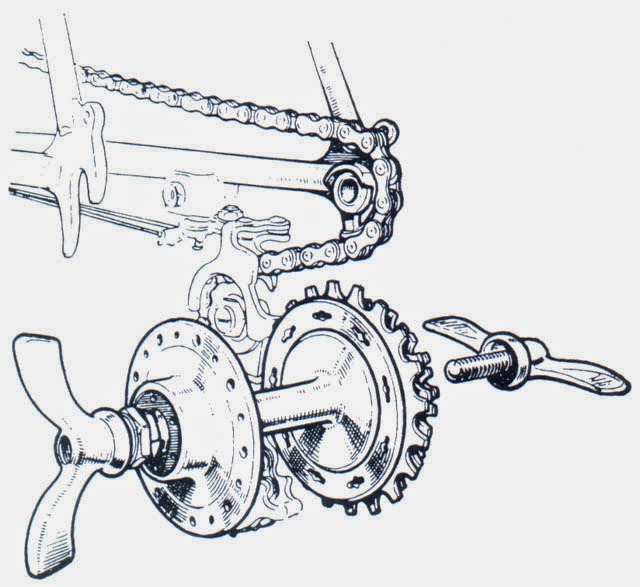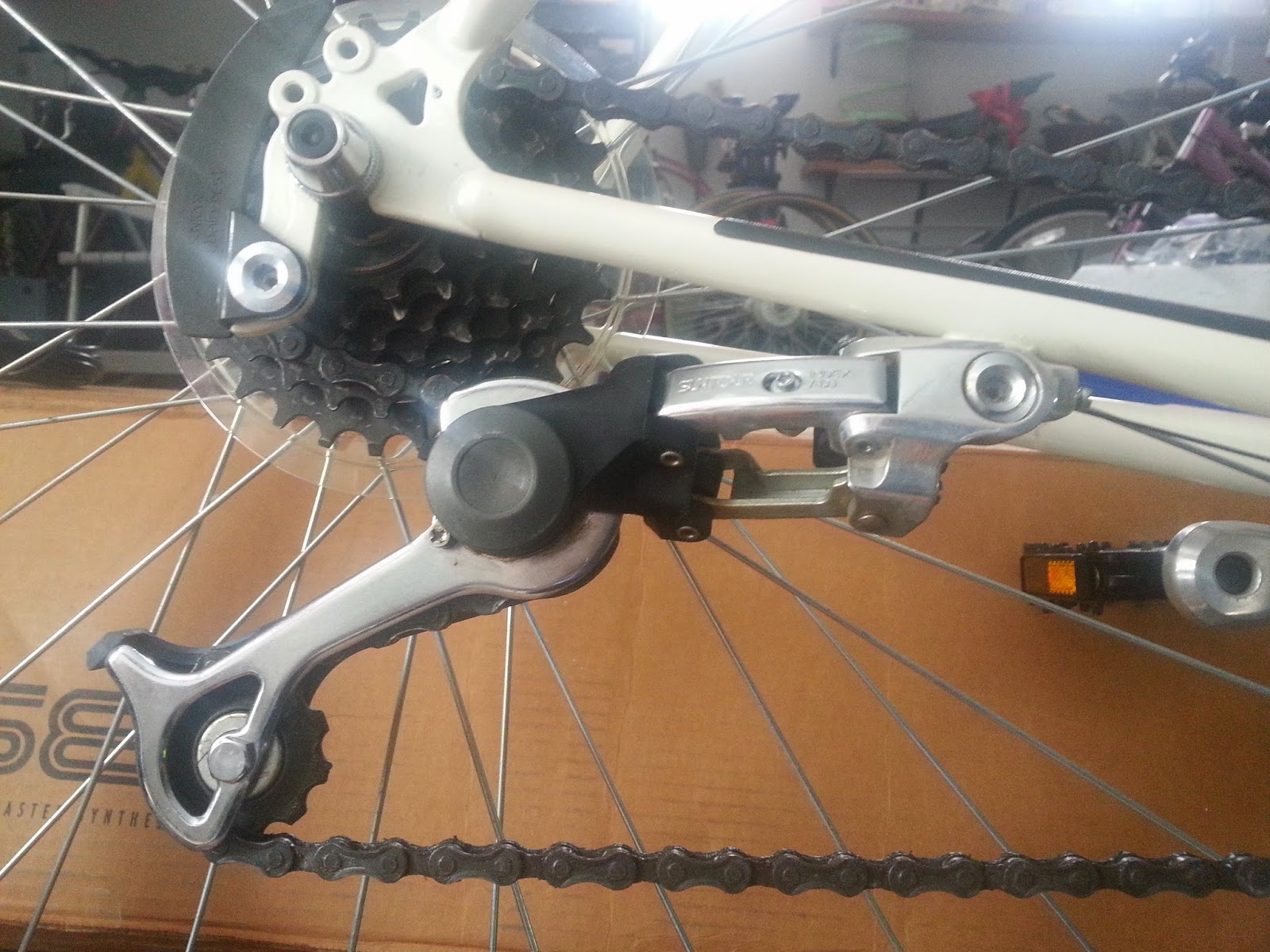A lot of people credit the Campagnolo Gran Sport as the first parallelogram derailleur. A lot of people would be wrong.
While Campagnolo's Gran Sport was a breakthrough design, particularly among racers, and was the design that spawned many copies and imitators, another, superior parallelogram derailleur was introduced more than ten years earlier: the Nivex.
The Nivex was first made in 1938, and is named in Frank Berto's authoritative history The Dancing Chain as the first parallelogram derailleur. Like some other touring derailleurs from the era, such as the popular Cyclo, it mounted to the right chain stay, forward of the rear axle. Its movement was controlled with dual cables, as the parallelogram did not have a return spring. It did have a coil spring for chain tension with a unique linkage that kept tension constant throughout the range, and it had a capacity of 28 teeth. Though it was mainly stamped steel construction, and not particularly pretty, it was acclaimed for its shifting performance.
Jan Heine, of Bicycle Quarterly, has praised the Nivex as one of the best-shifting derailleurs ever made. In a test of a 1962 Alex Singer, Heine wrote: "The Nivex derailleur shifted as precisely as always, but I had to adjust my technique. . . I had to stop 'over shifting.' With the Nivex, you move the lever until the new gear engages, and that's it. No fine-tuning necessary. The compensator lever on the spring keeps the chain tension constant, so every shift is exactly the same, no matter where you are in the gear range." (Jan Heine) Heine's respect for the Nivex is such that when he had a new, custom-built randonneur bike built in 2011, he had it built to use a vintage Nivex derailleur.
Notable frame builder Alex Singer was a particular fan of the Nivex design, eventually purchasing an interest in the company. On Singer's bicycles, the derailleur was chrome-plated and prettied up.
Unfortunately, however, apart from its use on some very nice cyclotouring bikes in the 40s and 50s, the Nivex derailleur just didn't catch on. Berto's book points out that it was first introduced during the economic recession that came just prior to WWII. Of course, the war years would have hampered the company's fortunes as well. Ultimately, the company didn't have the resources to market it to its full potential and production was ended some time in the 50s.
Nivex Descendants:
Years after losing its marketing power, SunTour took a look back to the Nivex when it designed its doomed S-1 in the early 90s. Like the Nivex, it mounted to the right chain stay, with the parallelogram pointing backwards towards the rear axle. It really was, in many ways, an updated, modernized version of the Nivex. Interestingly, it had an indexing mechanism built into the derailleur, rather than in the lever as in most index-shifting systems. Unfortunately for SunTour, it was introduced at a time when the market was clearly dominated by the Shimano juggernaut. Furthermore, it required a special mounting boss on the chain stay so it couldn't be simply retrofitted to existing bikes. As far as I know, the only company that specified the derailleur on any of its models was Schwinn, on its '93 Criss Cross -- a touring/hybrid model. Without any other OEM support, and no aftermarket demand, the S-1 faded into obscurity after only a year or two.
Obviously, most derailleurs since the 1950s took their design cues from the Campagnolo Gran Sport design which mounted to a hangar on the rear dropout. Different manufacturers made incremental improvements to the design over the years, such as adding spring-loaded top pivots, or the drop-parallelogram which oriented the body in a more horizontal fashion, or even the slant parallelogram that canted the body so it pivoted downward as it moved inward for more consistent chain gap. All of those changes improved the shifting, but all of those incremental improvements did nothing more than to finally bring the "modern" rear derailleur up to the shifting performance available on the Nivex since 1938.
While Campagnolo's Gran Sport was a breakthrough design, particularly among racers, and was the design that spawned many copies and imitators, another, superior parallelogram derailleur was introduced more than ten years earlier: the Nivex.
| Image may be NSFW. Clik here to view.  |
| Classic Nivex parallelogram derailleur. This example has a clamp for mounting to the right chain stay. Other examples mounted directly to the stay without the clamp, for a more secure attachment. |
Jan Heine, of Bicycle Quarterly, has praised the Nivex as one of the best-shifting derailleurs ever made. In a test of a 1962 Alex Singer, Heine wrote: "The Nivex derailleur shifted as precisely as always, but I had to adjust my technique. . . I had to stop 'over shifting.' With the Nivex, you move the lever until the new gear engages, and that's it. No fine-tuning necessary. The compensator lever on the spring keeps the chain tension constant, so every shift is exactly the same, no matter where you are in the gear range." (Jan Heine) Heine's respect for the Nivex is such that when he had a new, custom-built randonneur bike built in 2011, he had it built to use a vintage Nivex derailleur.
Notable frame builder Alex Singer was a particular fan of the Nivex design, eventually purchasing an interest in the company. On Singer's bicycles, the derailleur was chrome-plated and prettied up.
Unfortunately, however, apart from its use on some very nice cyclotouring bikes in the 40s and 50s, the Nivex derailleur just didn't catch on. Berto's book points out that it was first introduced during the economic recession that came just prior to WWII. Of course, the war years would have hampered the company's fortunes as well. Ultimately, the company didn't have the resources to market it to its full potential and production was ended some time in the 50s.
| Image may be NSFW. Clik here to view.  |
| Here's a Nivex mounted onto a classic randonneur bike. Notice how the parallelogram's natural arc of movement carries it both inward and forward, thereby keeping a consistent gap with the cogs. The Campagnolo-type parallelogram, hanging downward behind/below the axle, moves inward and upward, so it has a closer gap to the larger cogs, and a wider gap to the smaller cogs, leading to inconsistent shifting across the range. Frank Berto's The Dancing Chain says that Tullio Campagnolo purchased a couple of Nivex units in 1947 or '48. He must have decided that racers would prefer a derailleur that hung from the rear dropout, however, as the articulating parallelogram was the only element he used on the Gran Sport. |
| Image may be NSFW. Clik here to view.  |
| Some bikes made for the Nivex derailleur, like some of those from Alex Singer, had special hubs and dropouts. For wheel removal, one would shift the chain onto an integrated chain holder on the dropout, then undo the special wing nuts with semi-axles that thread into the hub. Once removed, the wheel dropped out cleanly without touching the chain. |
Nivex Descendants:
Years after losing its marketing power, SunTour took a look back to the Nivex when it designed its doomed S-1 in the early 90s. Like the Nivex, it mounted to the right chain stay, with the parallelogram pointing backwards towards the rear axle. It really was, in many ways, an updated, modernized version of the Nivex. Interestingly, it had an indexing mechanism built into the derailleur, rather than in the lever as in most index-shifting systems. Unfortunately for SunTour, it was introduced at a time when the market was clearly dominated by the Shimano juggernaut. Furthermore, it required a special mounting boss on the chain stay so it couldn't be simply retrofitted to existing bikes. As far as I know, the only company that specified the derailleur on any of its models was Schwinn, on its '93 Criss Cross -- a touring/hybrid model. Without any other OEM support, and no aftermarket demand, the S-1 faded into obscurity after only a year or two.
Image may be NSFW. Clik here to view.  |
| SunTour S-1 -- specified as standard equipment on the Schwinn Criss Cross in 1993. Note the brazed-on attachment point on the chain stay. Look closely, and you can see what appears to be a chain holder attached to the derailleur hanger, not terrifically different from the Nivex-equipped bikes of the past -- such an item would greatly simplify wheel removal, though one would almost certainly have to place the chain onto the holder by hand, so it wouldn't be quite as clean and effortless as the Nivex design. |
| Image may be NSFW. Clik here to view.  |
| Though not exactly the same as the Nivex, a similar idea (and clearly sharing some DNA with the SunTour S-1) lives on today in the Dahon Neos derailleur, made by SR/SunTour for use with some Dahon and Tern small-wheeled folding bikes. The biggest difference from the previous designs is that it mounts to the dropout, just ahead of the rear axle, as opposed to mounting to the chain stay. The advantage is supposed to be that it limits some of the damage that can occur to the derailleur when the bike is folded, or packed for travel. |
Obviously, most derailleurs since the 1950s took their design cues from the Campagnolo Gran Sport design which mounted to a hangar on the rear dropout. Different manufacturers made incremental improvements to the design over the years, such as adding spring-loaded top pivots, or the drop-parallelogram which oriented the body in a more horizontal fashion, or even the slant parallelogram that canted the body so it pivoted downward as it moved inward for more consistent chain gap. All of those changes improved the shifting, but all of those incremental improvements did nothing more than to finally bring the "modern" rear derailleur up to the shifting performance available on the Nivex since 1938.